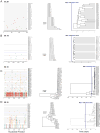HIV-1 and hepatitis C virus selection bottleneck in Chinese people who inject drugs
- PMID: 29194114
- PMCID: PMC5765877
- DOI: 10.1097/QAD.0000000000001702
HIV-1 and hepatitis C virus selection bottleneck in Chinese people who inject drugs
Abstract
Objectives: For both HIV-1 and hepatitis C virus (HCV), assessing the stringency of the transmission process is a scientific priority. Enumerations of transmitted/founder (TF) viruses have shown a strict transmission bottleneck in sexual transmission of HIV-1 and a wide range in the multiplicity of infection in HCV. Here, we aim to determine the stringency of parenteral transmission for HIV-1 and HCV in people who inject drugs (PWID).
Design: We used molecular sequencing and several complementary analyses to enumerate the TF HIV-1 and HCV variants in a well described cohort of PWID in Xinjiang, China.
Methods: We performed single genome sequencing of HIV-1 env and 5' half HCV genomes, then applied phylogenetic analysis and validated models of early virus diversification to enumerate TF viruses in 60 PWID. We used multivariate analysis to determine correlates of multivariant transmission (MVT).
Results: We generated 1070 env region sequences from 33 HIV-1 early infected individuals and 773 5' half region sequences from 27 HCV early infected individuals. We found rates of MVT of 39 and 54%, respectively, for HIV-1 and HCV, with a limited range in the number of TF viruses in both infections. Behavioural characteristics suggested high-risk injection practices and lower risk sexual practices; we did not find an association between any specific behaviours and MVT.
Conclusion: MVT is frequent in parenteral transmission of both HIV-1 and HCV in Xinjiang PWID, indicating a less stringent transmission process than sexual transmission.
Figures


Similar articles
-
Using HIV and Hepatitis C Molecular Epidemiology to Investigate Assisted Partner Services Recruitment Among People Who Inject Drugs in Kenya.AIDS Res Hum Retroviruses. 2025 Feb;41(2):76-86. doi: 10.1089/aid.2024.0036. Epub 2024 Dec 16. AIDS Res Hum Retroviruses. 2025. PMID: 39686724
-
Molecular characterization of human immunodeficiency virus type 1 and hepatitis C virus in paid blood donors and injection drug users in china.J Virol. 2004 Dec;78(24):13591-9. doi: 10.1128/JVI.78.24.13591-13599.2004. J Virol. 2004. PMID: 15564470 Free PMC article.
-
Epidemiological distribution and genotype characterization of hepatitis C virus and HIV co-infection in Wuhan, China, where the prevalence of HIV is low.J Med Virol. 2013 Oct;85(10):1712-23. doi: 10.1002/jmv.23650. Epub 2013 Jul 19. J Med Virol. 2013. PMID: 23868809
-
Hepatitis C virus vaccines among people who inject drugs.Clin Infect Dis. 2013 Aug;57 Suppl 2(Suppl 2):S46-50. doi: 10.1093/cid/cit329. Clin Infect Dis. 2013. PMID: 23884065 Free PMC article. Review.
-
Management of hepatitis C virus/HIV coinfection among people who use drugs in the era of direct-acting antiviral-based therapy.Clin Infect Dis. 2013 Aug;57 Suppl 2(Suppl 2):S118-24. doi: 10.1093/cid/cit326. Clin Infect Dis. 2013. PMID: 23884059 Free PMC article. Review.
References
Publication types
MeSH terms
Substances
Grants and funding
LinkOut - more resources
Full Text Sources
Other Literature Sources
Medical
Miscellaneous

